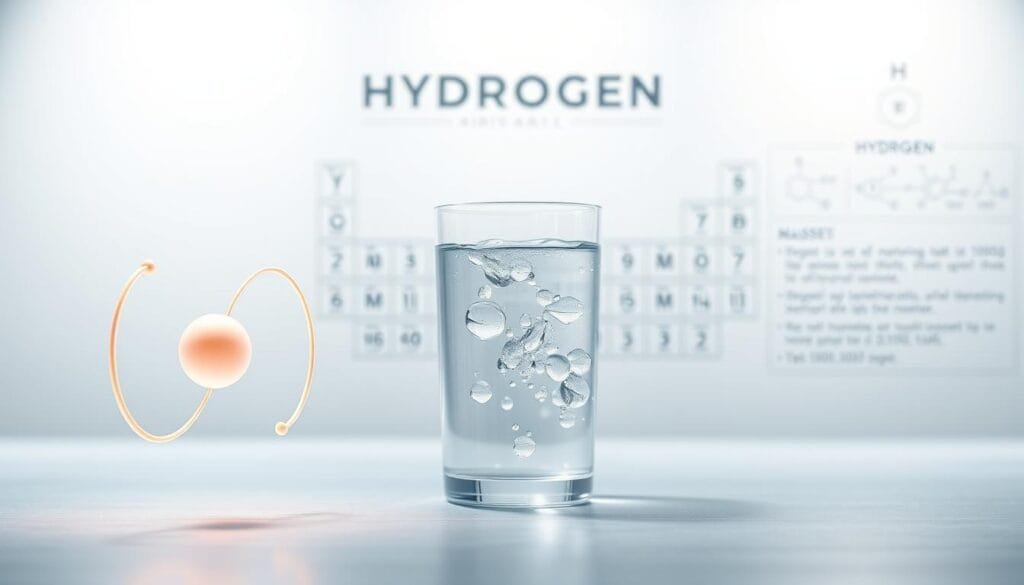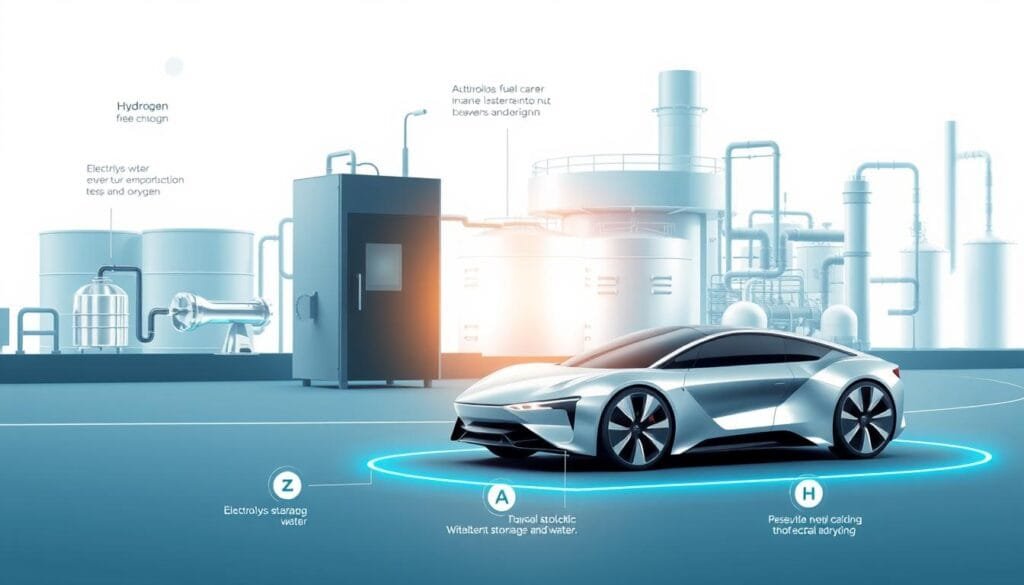Currently Empty: RM0.00
Did you know that hydrogen makes up 75% of the universe’s normal matter? This element is not only the lightest but also the most abundant in existence. With just one proton and one electron, it holds a unique place in science and nature.
Its simple structure makes it a cornerstone of atomic studies. From powering stars to fueling clean energy, hydrogen plays a vital role in both cosmic and earthly processes. Understanding its properties opens doors to innovations in technology and sustainability.
For more science-related inquiries, contact Wellness Concept at +60123822655. Their team is available Mon-Fri 9:30am-6:30pm and Sat-Sun 10am-5pm.
This article will explore its isotopes, practical applications, and fascinating quantum properties. Dive in to uncover the wonders of this essential element.
Key Takeaways
- Hydrogen constitutes 75% of the universe’s normal matter.
- It has a simple atomic structure with one proton and one electron.
- Hydrogen is crucial for both cosmic and technological advancements.
- Wellness Concept offers support for science-related questions.
- The article will delve into isotopes, applications, and quantum properties.
Introduction to Hydrogen: The Smallest Atom
First isolated in 1766, hydrogen has fascinated scientists for centuries. Henry Cavendish, a British scientist, was the first to recognize it as a distinct element. Later, Antoine Lavoisier named it “hydrogen,” derived from Greek words meaning “water-former,” as it produces water when burned.
This element is the simplest in existence, with an atomic number of 1. It consists of just one proton and one electron, making it the lightest and most basic building block of matter. Its simplicity makes it a cornerstone of atomic studies and a key player in both chemistry and physics.
Hydrogen exists naturally as a colorless, odorless gas. It forms diatomic molecules, meaning two hydrogen atoms bond together to create H₂. This gas is highly flammable and reacts easily with other elements, showcasing its versatility.
In the periodic table, hydrogen holds a unique position. It is placed in Group 1 and Period 1, reflecting its single proton and electron. Despite its simplicity, its behavior can be complex, especially when comparing atomic size to mass.
- Discovered by Henry Cavendish in 1766.
- Named by Antoine Lavoisier, meaning “water-former.”
- Exists as a colorless, diatomic gas (H₂).
- Positioned in Group 1, Period 1 of the periodic table.
- Simplest element with one proton and one electron.
Understanding hydrogen is essential for exploring the universe and advancing technology. Its unique properties make it a vital component in everything from stars to clean energy solutions.
The Atomic Structure of Hydrogen
Hydrogen’s atomic structure is as simple as it is fascinating. At its core, it consists of just one proton and one electron, making it the most basic element in the periodic table. This simplicity allows scientists to study it as a model for understanding more complex elements.
The nucleus of hydrogen contains only a single proton, with no neutrons in its most common form. This form, known as protium, accounts for 99.98% of naturally occurring hydrogen. Its single electron orbits the nucleus, creating a stable and straightforward atomic configuration.
Proton, Electron, and Neutron Composition
Protium, the most abundant isotope, has no neutrons. This makes it the lightest and simplest form of hydrogen. Deuterium, another isotope, includes one neutron in its nucleus. Tritium, the rarest isotope, contains two neutrons and is radioactive.
These variations in neutron count give each isotope unique properties. For example, deuterium is used in NMR spectroscopy and heavy water production. Tritium, with its 12.32-year half-life, is used in luminescent applications like watch dials.
Isotopes of Hydrogen
Hydrogen has three primary isotopes: protium, deuterium, and tritium. Each differs in neutron count and stability. Protium is stable and abundant, while deuterium and tritium have specialized uses in science and industry.
Nuclear spin isomers, known as ortho and para hydrogen, further complicate its behavior. Ortho-hydrogen has parallel nuclear spins, while para-hydrogen has antiparallel spins. These isomers affect hydrogen’s physical properties, such as boiling points.
| Isotope | Protons | Neutrons | Abundance | Applications |
|---|---|---|---|---|
| Protium (¹H) | 1 | 0 | 99.98% | Basic atomic studies |
| Deuterium (²H) | 1 | 1 | 0.0145% | NMR spectroscopy, heavy water |
| Tritium (³H) | 1 | 2 | Trace amounts | Luminescent uses, radioactive studies |
Exotic forms of hydrogen, such as antihydrogen and muonium, also exist. Antihydrogen consists of an antiproton and a positron, while muonium replaces the electron with a muon. These forms are studied in advanced physics to explore fundamental particles and forces.
Properties of Hydrogen

Hydrogen’s unique characteristics make it a standout element in the periodic table. Its physical properties and chemical properties define its behavior in various environments. From its low density to its explosive potential, this element is both fascinating and essential.
Physical Properties
Hydrogen undergoes phase changes at cryogenic temperatures. It melts at -259.16°C and boils at -252.879°C, making it one of the coldest substances on Earth. Its low density allows it to rise rapidly in the atmosphere, often escaping into space.
Safety is crucial when handling this element. It is highly flammable in air, with explosive limits between 4% and 74% concentration. Proper storage and handling are essential to prevent accidents.
Chemical Properties
Hydrogen’s chemical properties are equally remarkable. It forms covalent bonds with nonmetals, creating compounds like water and methane. Its heat of combustion is 141.865 MJ/kg, making it a powerful energy source.
Unlike helium, which is inert, hydrogen actively participates in chemical reactions. It can form hydrides with metals, expanding its versatility in industrial applications. Its atomic radius is among the smallest, contributing to its unique reactivity.
- Phase changes occur at extremely low temperatures.
- Flammable in air, requiring careful handling.
- Forms covalent bonds with nonmetals.
- Comparatively reactive, unlike helium.
- Capable of hydride formation with metals.
Hydrogen in the Universe
The universe owes much of its existence to hydrogen, the simplest yet most abundant element. Formed just 370,000 years after the Big Bang, it played a pivotal role in shaping the cosmos. Today, it remains a cornerstone of stellar and intergalactic processes.
In the cores of stars, hydrogen exists as a plasma, a state where atoms are stripped of their electrons. This plasma fuels nuclear fusion, converting hydrogen into helium and releasing immense energy. This process, known as stellar nucleosynthesis, powers stars and creates heavier elements.
Hydrogen’s cosmic abundance far exceeds its availability on Earth. It makes up about 75% of the universe‘s normal matter, yet it’s scarce in our planet’s atmosphere. This disparity highlights its role in the vastness of space compared to terrestrial environments.
During the early universe, hydrogen contributed to cooling and recombination, allowing light to travel freely. This era, known as the cosmic dark ages, set the stage for the formation of galaxies and stars. Hydrogen’s behavior during this period is crucial for understanding the universe’s evolution.
Researchers also explore hydrogen’s connection to dark matter. Its distribution and ionization history in the intergalactic medium provide clues about this mysterious substance. By studying hydrogen, scientists hope to unravel the secrets of dark matter and the universe’s structure.
- Hydrogen fuels stellar nucleosynthesis in stars.
- It exists as a plasma in stellar cores.
- Cosmic abundance exceeds terrestrial availability.
- Played a key role in the early universe’s cooling.
- Linked to dark matter research through ionization history.
Hydrogen on Earth
On Earth, hydrogen plays a crucial role in both natural and industrial processes. It is a key component of water, which covers about 71% of the planet’s surface. Additionally, it forms the backbone of many organic compounds, making it essential for life as we know it.
Hydrogen in Water and Organic Compounds
Water, or H₂O, is one of the most abundant and vital compounds on Earth. Its molecular structure consists of two hydrogen atoms bonded to one oxygen atom. This simple yet powerful combination supports all forms of life, from cellular functions to global ecosystems.
In organic compounds, hydrogen is a fundamental building block. It is present in carbohydrates, lipids, and proteins, which are essential for biological processes. For example, glucose, a primary energy source for cells, contains hydrogen atoms that contribute to its mass and reactivity.
Hydrogen Gas Production
Hydrogen gas is primarily produced through industrial methods. Steam methane reforming accounts for about 90% of global production. This process involves reacting methane with steam to produce hydrogen and carbon dioxide.
Electrolysis, another method, splits water into hydrogen and oxygen using electricity. While it offers a cleaner alternative, its efficiency remains a challenge. Green hydrogen initiatives aim to improve this process by using renewable energy sources.
Storage is another critical aspect. Hydrogen can be stored as a compressed gas or in liquid form, each with its own advantages and challenges. Compressed gas is easier to handle, while liquid hydrogen offers higher energy density.
| Production Method | Process | Efficiency | Environmental Impact |
|---|---|---|---|
| Steam Methane Reforming | Methane + Steam → Hydrogen + CO₂ | High | High CO₂ emissions |
| Electrolysis | Water → Hydrogen + Oxygen | Moderate | Low (with renewable energy) |
| Green Hydrogen | Electrolysis using renewables | Improving | Minimal |
Hydrogen’s versatility and abundance make it a cornerstone of Earth’s natural and industrial systems. From sustaining life to powering industries, its impact is undeniable.
Applications of Hydrogen

Hydrogen’s versatility extends far beyond its atomic simplicity. This element plays a pivotal role in both traditional industries and cutting-edge technologies. From manufacturing to transportation, its applications are vast and transformative.
Industrial Uses
In the industrial sector, hydrogen is indispensable. One of its primary applications is in ammonia production, which exceeds 70 million tons annually. Ammonia is a key ingredient in fertilizers, supporting global agriculture and food security.
Hydrogen also plays a crucial role in petroleum refining. It helps remove impurities from crude oil, enhancing the quality of fuels. Additionally, it is used in chemical synthesis, producing methanol and other essential compounds.
Emerging Technologies
Hydrogen is at the forefront of innovation in clean energy. Fuel cells, for instance, convert hydrogen into electricity with up to 60% efficiency. These cells power vehicles, offering a sustainable alternative to fossil fuels.
In aerospace, hydrogen serves as rocket fuel due to its high energy density. It is also a focus of nuclear fusion research, which aims to replicate the energy-producing processes of stars. These advancements highlight hydrogen’s potential to revolutionize energy systems.
- Essential in fertilizer manufacturing and petroleum refining.
- Drives clean energy solutions like fuel cells.
- Used in aerospace applications, including rocket fuel.
- Central to nuclear fusion research for sustainable energy.
For inquiries about hydrogen technologies, contact Wellness Concept at +60123822655. Their team is available Mon-Fri 9:30am-6:30pm and Sat-Sun 10am-5pm.
Hydrogen and Quantum Mechanics
Quantum mechanics provides a deeper understanding of hydrogen’s behavior. This element serves as a foundational model for exploring atomic and subatomic phenomena. Its simplicity allows scientists to apply the Schrödinger equation effectively, revealing the electron’s probability distribution within the atom.
The Bohr model was one of the first to describe hydrogen’s atomic structure. It introduced the concept of quantized energy levels, where the electron orbits the nucleus at specific distances. This model laid the groundwork for modern quantum theory, though it was later refined by the Schrödinger equation.
Hydrogen’s hyperfine structure is another key area of study. It arises from interactions between the electron and the proton’s magnetic moments. This phenomenon is crucial for applications like atomic clocks and precision measurements.
The Rydberg constant plays a significant role in hydrogen’s spectral lines. It defines the wavelengths of light emitted or absorbed during electron transitions. These spectral lines, such as the Balmer series, are visible in the light spectrum and are used in spectroscopy to analyze celestial objects.
Quantum tunneling is another fascinating aspect of hydrogen’s behavior. It allows particles to pass through energy barriers that would otherwise be insurmountable. This effect is essential in nuclear fusion processes, where hydrogen nuclei overcome repulsive forces to merge.
- Schrödinger equation describes electron probability distributions.
- Hyperfine structure results from magnetic interactions.
- Rydberg constant defines spectral line wavelengths.
- Quantum tunneling enables nuclear fusion.
- Spectroscopy uses hydrogen’s spectral lines for analysis.
Hydrogen Safety and Handling
Ensuring safe practices with hydrogen is critical due to its unique properties. This gas is highly flammable, with an autoignition temperature of 500°C. Its invisible flame makes it challenging to detect without specialized equipment, emphasizing the need for proper handling.
Storage tanks for hydrogen must meet stringent design requirements. Double-walled, vacuum-insulated tanks are essential for liquid hydrogen to prevent leaks and accommodate gas expansion. Proper buffer space is also crucial to manage volume changes safely.
Leak detection is another vital aspect of safety. Since hydrogen is colorless, odorless, and tasteless, special detectors are necessary to identify leaks promptly. Early detection can prevent potential explosion hazards and ensure a safe environment.
Hydrogen can cause embrittlement in certain materials, weakening their structural integrity. Preventing this requires using compatible materials and regular inspections. Transportation regulations further ensure that hydrogen is moved safely, minimizing risks during transit.
Emergency response protocols are essential for addressing incidents involving hydrogen. Quick and effective actions can mitigate the impact of leaks or explosions, protecting both people and property. For more detailed guidelines, visit the safety of hydrogen systems page.
- Double-walled, vacuum-insulated storage tanks are mandatory.
- Special detectors are required for leak identification.
- Prevent embrittlement by using compatible materials.
- Follow strict transportation regulations for safe transit.
- Implement emergency response protocols for incident management.
Conclusion: The Significance of Hydrogen
Hydrogen’s role in shaping the future of energy and science cannot be overstated. As the simplest and most abundant element, it holds a unique position in chemistry and technology. Its potential to reduce energy costs by up to 50% through fusion technology highlights its significance in the global energy transition.
Beyond its environmental impact, hydrogen is at the forefront of clean energy solutions. From powering fuel cells to advancing nuclear fusion research, it offers a sustainable path forward. Ongoing studies continue to explore its applications, ensuring its relevance for years to come.
For those interested in learning more about hydrogen’s potential, Wellness Concept is available to assist. Their team can be reached at +60123822655, Mon-Fri 9:30am-6:30pm and Sat-Sun 10am-5pm. Engage with experts to discover how hydrogen can shape a cleaner, brighter future.
FAQ
What makes hydrogen unique among elements?
Hydrogen stands out because it has just one proton and one electron, making it the simplest and lightest element in the periodic table.
How does the atomic structure of hydrogen differ from other atoms?
Unlike heavier elements, hydrogen’s nucleus contains only a single proton, and it typically lacks neutrons in its most common form.
What are the isotopes of hydrogen?
Hydrogen has three isotopes: protium (no neutrons), deuterium (one neutron), and tritium (two neutrons).
What are the physical properties of hydrogen?
It is a colorless, odorless gas with the lowest density of all elements, and it becomes a liquid at extremely low temperatures.
How does hydrogen behave chemically?
It is highly reactive, forming compounds like water (H₂O) and methane (CH₄), and it readily bonds with other elements.
Why is hydrogen abundant in the universe?
It was the first element formed after the Big Bang and remains the most common, making up about 75% of the universe’s elemental mass.
Where is hydrogen found on Earth?
It is primarily found in water and organic compounds, and it can be extracted from natural gas or produced through electrolysis.
What are the industrial uses of hydrogen?
It is used in refining petroleum, producing ammonia for fertilizers, and manufacturing methanol and other chemicals.
How is hydrogen used in emerging technologies?
It powers fuel cells for vehicles, stores renewable energy, and is being explored as a clean energy source for the future.
What role does hydrogen play in quantum mechanics?
Its simple structure makes it a key subject for studying atomic behavior and quantum theory.
What safety precautions are needed when handling hydrogen?
Due to its flammability, it requires careful storage, ventilation, and handling to prevent accidents.


